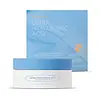What's inside
What's inside
 Key Ingredients
Key Ingredients

 Benefits
Benefits

 Concerns
Concerns

No concerns
 Ingredients Side-by-side
Ingredients Side-by-side

Water
Skin ConditioningPropanediol
SolventSodium Hyaluronate
HumectantLevulinic Acid
PerfumingGlycerin
HumectantSodium Levulinate
Skin ConditioningPentylene Glycol
Skin ConditioningSodium Anisate
AntimicrobialSodium Hydroxide
BufferingInulin
Skin ConditioningSodium Polyglutamate
HumectantSodium Acetylated Hyaluronate
HumectantAlpha-Glucan Oligosaccharide
CleansingSodium Hyaluronate Crosspolymer
HumectantHydrolyzed Sodium Hyaluronate
Skin ConditioningEthylhexylglycerin
Skin ConditioningWater, Propanediol, Sodium Hyaluronate, Levulinic Acid, Glycerin, Sodium Levulinate, Pentylene Glycol, Sodium Anisate, Sodium Hydroxide, Inulin, Sodium Polyglutamate, Sodium Acetylated Hyaluronate, Alpha-Glucan Oligosaccharide, Sodium Hyaluronate Crosspolymer, Hydrolyzed Sodium Hyaluronate, Ethylhexylglycerin
Water
Skin ConditioningGlycerin
HumectantDipropylene Glycol
HumectantChondrus Crispus Powder
AbrasiveBenzyl Glycol
SolventCeratonia Siliqua Gum
EmollientXanthan Gum
EmulsifyingPEG-60 Hydrogenated Castor Oil
EmulsifyingPanthenol
Skin ConditioningAllantoin
Skin ConditioningEthylhexylglycerin
Skin ConditioningTocopheryl Acetate
AntioxidantDipotassium Glycyrrhizate
HumectantRaspberry Ketone
MaskingCI 77007
Cosmetic ColorantDisodium EDTA
Synthetic Fluorphlogopite
Calcium Lactate
AstringentParfum
Masking1,2-Hexanediol
Skin ConditioningCI 77891
Cosmetic ColorantHydrolyzed Collagen
EmollientButylene Glycol
HumectantSodium Hyaluronate
HumectantHydroxypropyl Methylcellulose
Emulsion StabilisingPullulan
Hydroxypropyltrimonium Hyaluronate
Porphyridium Cruentum Extract
Skin ConditioningSodium Acetylated Hyaluronate
HumectantHydrolyzed Hyaluronic Acid
HumectantPolyglyceryl-10 Laurate
Skin ConditioningHyaluronic Acid
HumectantSodium Hyaluronate Crosspolymer
HumectantHydrolyzed Sodium Hyaluronate
Skin ConditioningPotassium Hyaluronate
Skin ConditioningPalmitoyl Tripeptide-1
Skin ConditioningPalmitoyl Pentapeptide-4
Skin ConditioningHexapeptide-9
Skin ConditioningAcetyl Hexapeptide-8
HumectantTripeptide-1
Skin ConditioningCopper Tripeptide-1
Skin ConditioningWater, Glycerin, Dipropylene Glycol, Chondrus Crispus Powder, Benzyl Glycol, Ceratonia Siliqua Gum, Xanthan Gum, PEG-60 Hydrogenated Castor Oil, Panthenol, Allantoin, Ethylhexylglycerin, Tocopheryl Acetate, Dipotassium Glycyrrhizate, Raspberry Ketone, CI 77007, Disodium EDTA, Synthetic Fluorphlogopite, Calcium Lactate, Parfum, 1,2-Hexanediol, CI 77891, Hydrolyzed Collagen, Butylene Glycol, Sodium Hyaluronate, Hydroxypropyl Methylcellulose, Pullulan, Hydroxypropyltrimonium Hyaluronate, Porphyridium Cruentum Extract, Sodium Acetylated Hyaluronate, Hydrolyzed Hyaluronic Acid, Polyglyceryl-10 Laurate, Hyaluronic Acid, Sodium Hyaluronate Crosspolymer, Hydrolyzed Sodium Hyaluronate, Potassium Hyaluronate, Palmitoyl Tripeptide-1, Palmitoyl Pentapeptide-4, Hexapeptide-9, Acetyl Hexapeptide-8, Tripeptide-1, Copper Tripeptide-1
Ingredients Explained
These ingredients are found in both products.
Ingredients higher up in an ingredient list are typically present in a larger amount.
Ethylhexylglycerin (we can't pronounce this either) is commonly used as a preservative and skin softener. It is derived from glyceryl.
You might see Ethylhexylglycerin often paired with other preservatives such as phenoxyethanol. Ethylhexylglycerin has been found to increase the effectiveness of these other preservatives.
Glycerin is already naturally found in your skin. It helps moisturize and protect your skin.
A study from 2016 found glycerin to be more effective as a humectant than AHAs and hyaluronic acid.
As a humectant, it helps the skin stay hydrated by pulling moisture to your skin. The low molecular weight of glycerin allows it to pull moisture into the deeper layers of your skin.
Hydrated skin improves your skin barrier; Your skin barrier helps protect against irritants and bacteria.
Glycerin has also been found to have antimicrobial and antiviral properties. Due to these properties, glycerin is often used in wound and burn treatments.
In cosmetics, glycerin is usually derived from plants such as soybean or palm. However, it can also be sourced from animals, such as tallow or animal fat.
This ingredient is organic, colorless, odorless, and non-toxic.
Glycerin is the name for this ingredient in American English. British English uses Glycerol/Glycerine.
Learn more about GlycerinThis ingredient is created by putting sodium hyaluronate through hydrolysis.
You might know this as 'mini' or 'ultra low-molecular weight' hyaluronic acid. The small molecule size means it is able to travel deeper in the skin.
According to studies, low molecular-weight hyaluronic acid can:
One study from 2011 found ultra-low weight HA to show pro-inflammatory properties. Another study from 2022 found it to downregulate UV-B induced inflammation.
Hydrolysis is a process of changing a molecule using water or enzymes.
This ingredient is water-soluble.
Learn more about Hydrolyzed Sodium HyaluronateSodium Acetylated Hyaluronate is a type of Hyaluronic Acid.
Hyaluronic Acids help moisturize, soothe, and protect the skin.
Read about common types of Hyaluronic Acid here:
Sodium Hyaluronate
Hydrolyzed Hyaluronic Acid
Hyaluronic Acid
Sodium Hyaluronate is hyaluronic acid's salt form. It is commonly derived from the sodium salt of hyaluronic acid.
Like hyaluronic acid, it is great at holding water and acts as a humectant. This makes it a great skin hydrating ingredient.
Sodium Hyaluronate is naturally occurring in our bodies and is mostly found in eye fluid and joints.
These are some other common types of Hyaluronic Acid:
Learn more about Sodium HyaluronateSodium Hyaluronate Crosspolymer is a type of hyaluronic acid. In fact, it is modified version of hyaluronic acid.
The structure of Sodium Hyaluronate Crosspolymer allows it to stay in the skin's top layer for a longer period of time. This allows for even more hydration and humectant action than hyaluronic acid.
These are some other common types of Hyaluronic Acid:
Learn more about Sodium Hyaluronate CrosspolymerWater. It's the most common cosmetic ingredient of all. You'll usually see it at the top of ingredient lists, meaning that it makes up the largest part of the product.
So why is it so popular? Water most often acts as a solvent - this means that it helps dissolve other ingredients into the formulation.
You'll also recognize water as that liquid we all need to stay alive. If you see this, drink a glass of water. Stay hydrated!
Learn more about Water